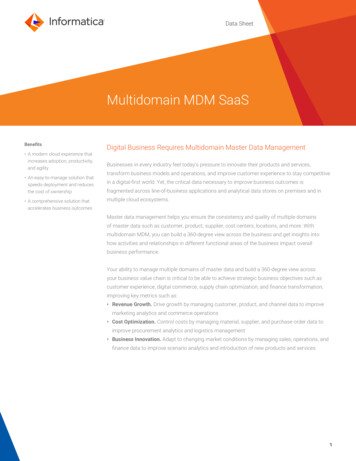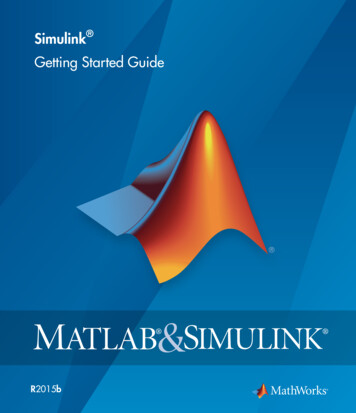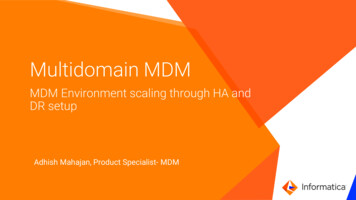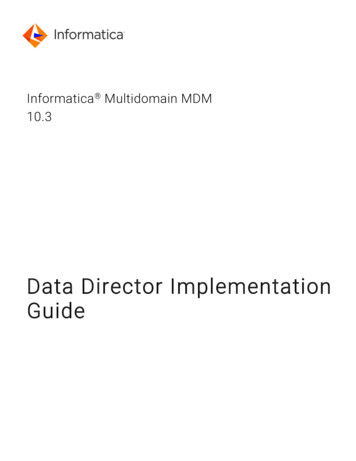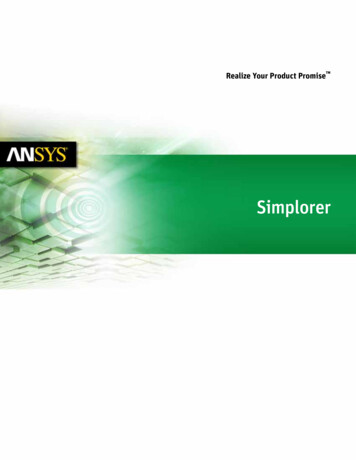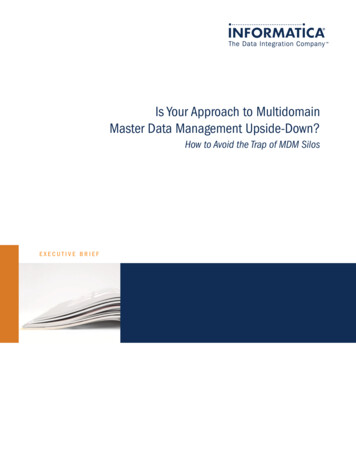
Transcription
Is Your Approach to MultidomainMaster Data Management Upside-Down?How to Avoid the Trap of MDM SilosEXECUTIVE BRIEF
Some master data management (MDM) technologies have created a misperception in the marketthat MDM is designed to solve only a single business problem. This could not be further fromthe truth. Fundamentally, MDM is designed to solve multiple complex business problems acrossbusiness units, departments, divisions, and regions—eliminating the need to create a unique MDMsolution for each business problem. The ability to start small by addressing one business problemand then scale to solve other business problems is the inherent beauty and value of MDM. Manycompanies recognize this fact and are successfully leveraging their multidomain MDM investmentsto solve many business problems, such as maximizing account penetration, optimizing accountcoverage, improving service delivery, introducing new products efficiently, obtaining more accuratereporting, and supporting compliance. Unfortunately, other companies are falling into the trap ofcreating more silos, rather than reducing them.Contrasting Two Approaches to Multidomain MDM:Application vs. PlatformThere are two distinct approaches to multidomain master data management: application MDMand platform MDM. Both can address a pressing business problem that is caused by inaccurate,incomplete, and inconsistent data. However, an application MDM approach is short sightedbecause it only solves the business problem for which it was designed. Because it comes with apredefined data model, business logic or functionality, and specific graphical user interface (GUI),it cannot be extended to other business problems. The concept is similar to buying an off-theshelf sales force automation (SFA) application for managing the sales pipeline or a procurementapplication to manage the purchase of direct or indirect materials for the supply chain. Theparadox of this approach is that it inevitably leads to more data silos and cost overruns. Becauseit starts with the application rather than the data, we call this the “upside-down” approach. SeeFigure 1.Figure 1: Depicts the contrast between the application approach or the “up-side-down” approach to MDM and theplatform approach or the “right-side-up” approach to MDM.2
Executive BriefIn contrast, the platform MDM approach takes a longer view. It can be extended to solve otherbusiness problems using the same MDM platform. This approach generates a higher ROI becausethe MDM technology investment can be used to evolve and scale to address additional businessproblems in a division, as well as the business problems encountered by other divisions,departments, and regions. Platform MDM is domain and data model independent. It allowsorganizations to flexibly define their own data model, generate logic and functionality based onthis defined model, and provide support to configure the GUI based on the functionality. Thisapproach lowers the total cost of ownership (TCO) and shortens the time to value. Because thisapproach starts with the data, we call this the “right-side-up” approach.For example, a Fortune 50 manufacturer decided to leverage a platform MDM approach toimprove buy-side and sell-side supply chain processes—in particular, to more effectively procuredirect and indirect materials and to improve the distribution of products. These complex businessissues involve managing vendor, customer, material, and product master data. Implementing acustomer data integration (CDI) or product information management (PIM) solution would onlysolve one dimension of the business issues. Such an application MDM approach would preventthe company from leveraging its technology investment to tackle other business problems thatinvolve the same types of data.To further illustrate how these two approaches differ, let’s look at another business problemexperienced by a global pharmaceutical company, which organizes its business into multipledivisions: conventional pharmaceuticals, over-the-counter medicines, biotechnology, and medicaldevices. The conventional pharmaceuticals division, which offers medicines for serious andwidespread diseases such as cancer, HIV/AIDS, and bacterial infections, encountered seriousproblems with compliance reporting. These problems arose because the antiquated systems itssales force used to track sales activities such as outreach to doctors, hospitals, and pharmacistswas plagued with duplicate records. Management and IT decision makers within this divisiondecided to address the problem through an MDM initiative that would result in an integratedphysician master. This physician master would cleanse, standardize, and consolidate informationfrom a variety of sources and then return it to the division’s sales force systems. With accuratedata on physician outreach, the division would be better able to generate accurate compliancereports in a timely manner.Implications of the Application or Upside-Down ApproachImagine if this IT group decided to use an application MDM or upside-down approach. Theywould have solved the pressing business problem of supporting compliance, but their approachwould constrain them from addressing other business problems that will likely arise in the future.A common example is that six months after going live with this new system, the operationsteam within the pharmaceuticals division identifies a business problem—duplications and othererrors and discrepancies in supply chain data is beginning to adversely impact its productionschedules. Not surprisingly, MDM would be the best solution for this problem. Unfortunately, thebusiness logic, GUI, and data model employed for the original MDM solution that addressedthe compliance reporting problem would not be able to address this new problem. Because theIs Your Approach to Multidomain Master Data Management Upside-Down?3
original MDM solution was purpose-built to handle a single business entity—the unique particularsof the division’s physician outreach and compliance processes—using the application MDMapproach, the MDM initiative could not scale to solve this next business problem. As a result,the pharmaceutical division would have to create an entirely new and separate MDM solutionto address this new supply chain data problem. Ultimately, the company would end up with twodistinct MDM silos, compounding the problem it set out to fix. See Figure 2.Implications of the Platform or Right-Side-Up ApproachNow imagine that the pharmaceutical division adopted the platform MDM or “right-side-up”approach. In this case, the first consideration is the data model—building a detailed guide towhere structured data is sourced from, how the various systems organize it, which applicationsdraw on it, when, and so forth. Once this critical step is resolved, then the GUI can be configuredto manage the data based on the business logic dictated by the business problem. By usingthis platform MDM approach, the IT team could have easily extended the system to handle anysubsequent business problems that might arise. This holds true not just for problems within thedivision but also for business problems facing other divisions, departments, regions, or the entireenterprise.For instance, the company could optimize the supply chain for the core pharmaceutical operation,enable the procurement team to improve contract management for the medical devices division,and enable marketing and sales to improve cross-sell and up-sell across the enterprise. Becausethe platform MDM approach is flexible, it can be used to create the most versatile multidomainMDM solution, allowing users to start with any domain, not just customer or product. In doing so,they can leverage the same technology investment to address any other type of business problemthat may arise.Figure 2: Using an application approach to MDM, IT teams solve the immediate business problem, but end upneeding to build new individual MDM applications to solve each unique business problem. In contrast, using aplatform approach to MDM, IT teams solve the immediate business problem, while positioning themselves to solvefuture business problems by leveraging their investments of time, resources and budget.4
Executive BriefPlatform MDM: Start with the Right-Side-UpOne of the great promises of multidomain master data management is that it removes the dataerrors and conflicts inherent in so many enterprises and ultimately eliminates redundant datastores and systems. However, using the application MDM approach makes it impossible torealize these benefits. In fact, this approach often leads companies to procure different MDMapplications to solve different problems, hence creating the same data silos that MDM wassupposed to eliminate. For these reasons, starting with the business logic, GUI, and then datamodel is actually backward, or upside-down, if you will.Multidomain MDM is by nature horizontal. It optimizes data, which is used to solve many businessproblems and is accessed through multiple business applications. Undertaking a successfulmultidomain MDM initiative requires a mind shift away from how IT groups typically solve businessproblems—using applications such as enterprise resource planning (ERP), customer relationshipmanagement (CRM), and supply chain management (SCM) to solve a single business problem.By using the platform MDM or right-side-up approach, IT groups can quickly address one businessproblem while positioning themselves to solve other business problems using the same platform.This enables them to lower the total cost of ownership and shorten time to value, which is theinherent beauty and value of MDM.About Informatica MDMInformatica MDM empowers business users to improve their operations with reliable viewsof critical master data distributed across data sources. The award-winning solution providescomprehensive, unified, open, and economical Master Data Management (MDM) on a singleplatform. It enables customers to manage multiple data domains and architectural styles andunifies all MDM requirements—data integration, profiling, quality, and master data management—on the same platform. Informatica MDM provides open data integration to all heterogeneousapplications and data sources. Informatica MDM delivers faster time-to-value, lower TCO,and superior ROI because it can be rapidly implemented and is easily configured to quicklyaccommodate ever changing business needs.Learn MoreLearn more about the Informatica Platform. Visit us at www.informatica.com orcall 1 650-385-5000 (1-800-653-3871 in the U.S.).About InformaticaInformatica Corporation (NASDAQ: INFA) is the world’s number one independent leader in dataintegration software. The Informatica Platform provides organizations with a comprehensive,unified, open, and economical approach to lower IT costs and gain competitive advantage fromtheir information assets. Nearly 4,000 enterprises worldwide rely on Informatica to access,integrate, and trust their information assets held in the traditional enterprise and in the Internetcloud. Visit www.informatica.com.Is Your Approach to Multidomain Master Data Management Upside-Down?5
Worldwide Headquarters, 100 Cardinal Way, Redwood City, CA 94063, USAphone: 650.385.5000 fax: 650.385.5500 toll-free in the US: 1.800.653.3871 www.informatica.com 2010 Informatica Corporation. All rights reserved. Printed in the U.S.A. Informatica, the Informatica logo, and The Data Integration Company are trademarks or registered trademarks of Informatica Corporation in the United States and injurisdictions throughout the world. All other company and product names may be trade names or trademarks of their respective owners. First Published: March 20107103 (03/19/2010)
unifies all MDM requirements—data integration, profiling, quality, and master data management— on the same platform. Informatica MDM provides open data integration to all heterogeneous applications and data sources. Informatica MDM delivers faster time-to-value, lower TCO, and superior ROI because it can be rapidly implemented and is easily .
